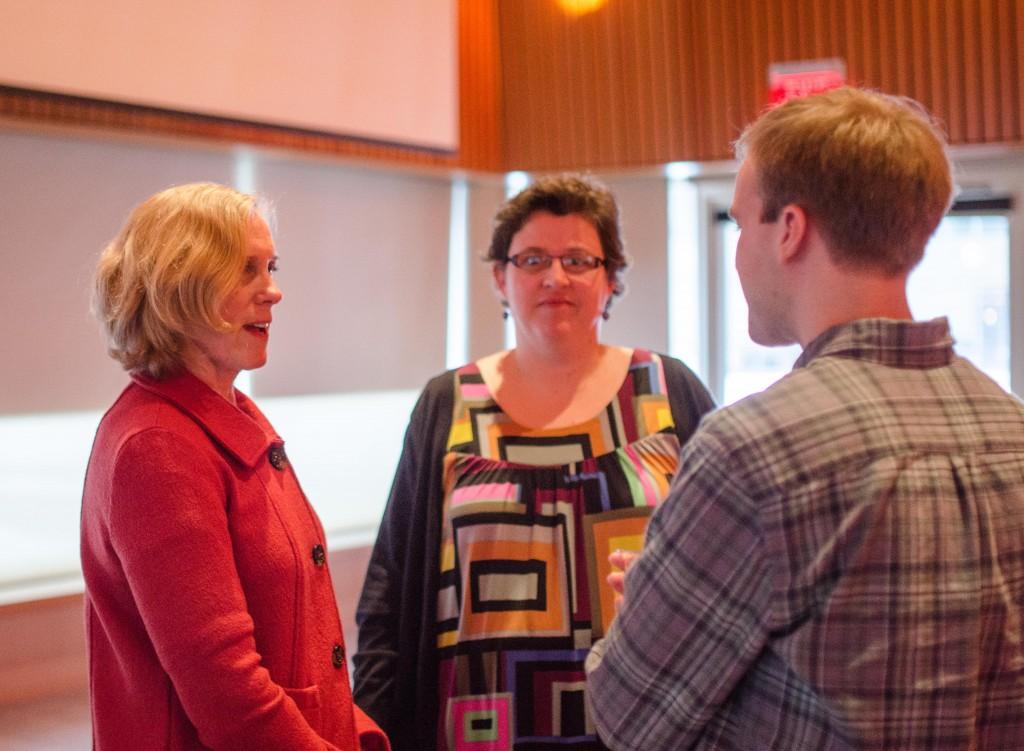On Tuesday, March 4, Bridget Brennan shared her experiences on the job as the Special Narcotics Prosecutor (SNP) for the City of New York in JRC 101, as part of the Rosenfield Program’s War on Drugs Symposium. In her presentation, “Heroin, Crack and Prescription Painkillers: Lessons Learned Over Forty Years of Fighting Crime and Addiction in New York City,” Brennan outlined some ideas that are contrary to the “typical” school of thought at Grinnell with regards to the legalization of drugs and the racialization of arrests.
The Office of the SNP is New York City’s primary narcotics prosecution agency and produces over 3,000 indictments a year. With jurisdiction across all five of New York’s boroughs, Brennan primarily targets drug trafficking organizations and leads large-scale police operations in tandem with state and federal investigations units. She is also the first woman to serve as the SNP of New York City, a position she has held since 1998.

Brennan began her presentation by describing the effects that narcotics such as heroin, opium and cocaine, and the illegal distribution of prescription drugs have had in New York City over the past four decades. When it comes to reducing drug usage, each new drug and every new scenario poses a new challenge, Brennan explained.
“Sometimes we have to just stick to a block-by-block approach,” Brennan said. “For example, heroin is a hierarchy, while crack is all over. On the other hand, the abuse of prescription painkillers is much harder to prosecute.”
As the SNP, Brennan concentrates her office’s efforts on stemming both the trafficking of illegal narcotics into the city and the relatively recent rise in prescription drug abuse. The Centers for Disease Control and Prevention has now classified prescription drug abuse as an epidemic.
“Our biggest problem now deals with prescription painkillers, as more people are addicted to opioid medication than heroin and cocaine combined,” Brennan said. “We’re seeing an increase in use amongst young people, and there are over seven million Americans abusing these drugs. The death rate from prescription painkillers is four times that of illicit drugs.”
Along the same lines, Brennan argued that the legalization of these “hard” drugs or the reduction of penalties for convicted drug addicts is not as effective a solution as some may think. Brennan believes that the rise of prescription drug abuse presents an interesting counterexample in regards to the perceived effectiveness of reducing crime and addiction by legalizing “harder” drugs.
“What would it mean to legalize drugs? Prescription drugs are legal drugs,” Brennan said. “Prescriptions for legal narcotics can be sold by doctors the same way drug dealers sell their street drugs, and the addicts act the same. This stuff is big money. That’s why you have the guns; that’s why people risk going to prison.”
Brennan contends that in the act of making illegal narcotics legal, nothing is done to address the addictiveness of medical opioids such as Oxycontin, which is the root of the problems associated with drug abuse.
“Addiction is an irrational compulsion to get the drug, and it becomes physical when it’s the opioid drugs. If you don’t get them, you get really, really dope-sick,” Brennan said. “It’s hard to just leave rationing out narcotics to somebody’s discretion because that compulsion overcomes reason, rationality and concern for your own and other people’s safety.”
Drug reform advocates regard legalization as the solution to high addiction rates, but Brennan said that her experiences do not support this view.
“In my experience, the more drugs that are out there, the more people will get addicted,” Brennan said. “When you saturate a market with these drugs, that’s when you get addicts. You have to crimp the supply lines.”
In order to reduce the supply of drugs, current laws in New York City place a stiffer penalty on the intent to distribute, while easing up on mere possession.
“Possessing illegal drugs is a misdemeanor, while selling drugs is a felony offense,” Brennan said. “The top of the supply chain faces much more substantial penalties than users do.”
Another solution commonly proposed by drug-policy advocates is encouraging addicts to seek treatment in favor of jail time, yet it could be the reduced penalties for addicts sponsored by the same groups that unravel the attractiveness and utility of addiction treatment, Brennan posited.
“Alternatives to incarceration are less in demand with the reduction of drug penalties,” Brennan said. “Addicts, for the most part, do not want treatment. They’ll take 60 days in jail and five years of probation over a year of in-patient treatment.”
Student attendees suggested that gentrification can also be credited with reducing crime rates, which Brennan argued was a confusion of cause and effect.
“Urban pioneers are rarely responsible for reducing drug usage,” Brennan said. “Gentrification doesn’t happen naturally, it happens when we get the drug situation under control, because nobody will move in when bullets are whizzing overhead.”
Brennan ended her talk by addressing the issue of perceived racial discrimination in drug arrests, arguing that accusations are often levied at supposed patterns which simply aren’t there.
“You cannot just make blanket assumptions, because each kind of drug dealing has its own demographic. The reason we typically see dealers and arrests within the same ethnic groups is the system of trust built through homogeneity,” Brennan said. “When it comes to cocaine, we primarily arrest Colombians, Mexicans and Dominicans because most of it comes from South America. Heroin addiction was the worst in black communities, so most of the people we arrested were black. Most prescription drug dealers are white, so the ones we arrest are almost all white.”
For Brennan, the effort is a never-ending one.
“It’s not a war—you do what you can to reduce the supply, so you reduce the impact,” she said.



















































